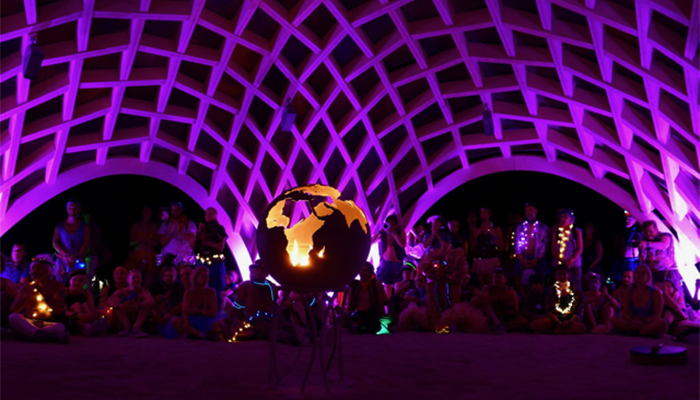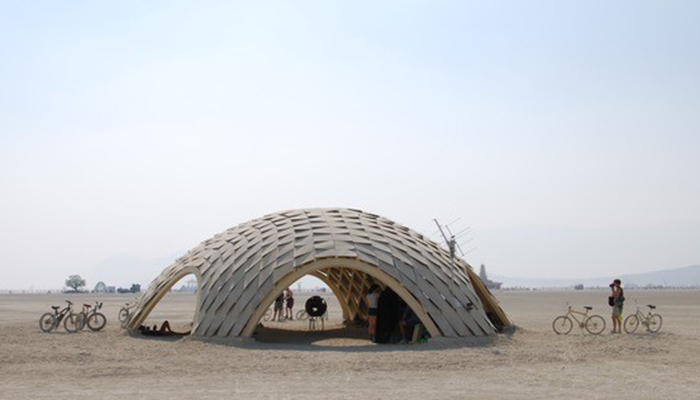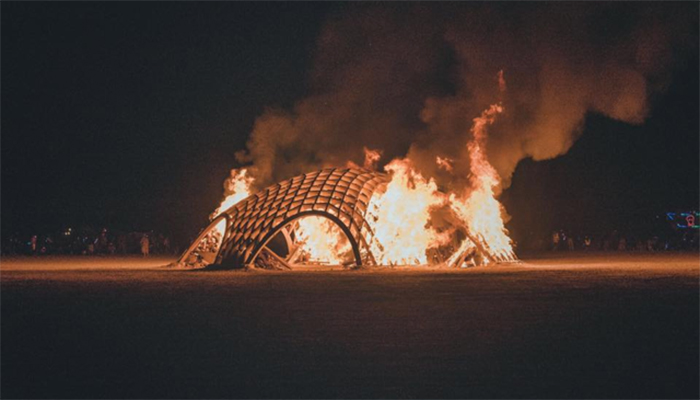Finnish design that conquered Burning Man can be utilised even in human settlements in Mars
The Cosmic Egg was built to the Nevada desert with the help of more than fifty volunteers.

An unbelievable idea and a fortunate encounter lead to the conquering of the event that celebrates creative madness, and which even the business directors in the Silicon Valley are big fans of.
In 2014, Anssi Laurila was at Burning Man listening to a presentation about stars and the universe, when he saw the International Space Station passing overhead.
‘There were seven people flying above us and I thought how amazing that was, and wondered if it would be possible to contact them. Then I concluded that I didn’t have the means to do it and I wouldn’t have known where to find the necessary expertise, either.’
The idea was brewing in his mind and came back to him at a May Day picnic a couple of years later when Laurila bumped into Tuomas Tikka, CEO of Reaktor Space Lab, who was working on his dissertation at Aalto University.
‘Tuomas got interested in the idea and we decided that next time we would to go to Burning Man with a space theme.’
Game designer grabbed a hammer
The core team consisting of members of the Aalto community was able to gather together a group of experts from a wide variety of fields. The group of over fifty volunteers included architects, structural engineers, researchers, a sound designer, a cosmetologist, a game designer, and a bookkeeper.
‘The most wonderful thing about the entire Space on Fire project is that it is co-created by the whole project team. Everyone was able to contribute, test their limits, and learn new skills. For example, the game designer had never held a hammer in his life, but he ended up being one of the best builders of the dome’, says Elina Koivisto.
‘And the bookkeeper saved us a considerable amount of money’, Laurila says and laughs.

Lunden Architecture Company was responsible for the architecture and structural design of the work. The company has long studied wooden shell structures in a development project of its own, and Burning Man provided a good opportunity to test the structure without arduous permit processes. The architecture and structural design of the work were implemented using the tools and means of parametric design, in which models of different sizes and forms can be produced for the structure and its façade by changing the initial values entered to the algorithm.
‘Later on, this parametric design piloted at Burning Man, , can be used to produce extremely strong and light structures that can be used, for example, in human settlements in Mars by taking advantage of 3D printing and composite materials’, Koivisto explains.
The Cosmic Egg also included a satellite ground station that was used for monitoring satellites orbiting the Earth and listening to cosmic background radiation. These space signals were combined with shamanistic sound theme from Finland. The result was a calming soundscape that was very different from the cacophony of Burning Man around it.
‘There was also a microphone inside the work that visitors could use to send messages to our neighbouring galaxy Andromeda. And because the Kalevala tradition has it that the world was born from an egg, there was a hearth at the centre of ‘Munanen’ (the Cosmic Egg) – a warming globe fuelled by propane inviting visitors to approach it. We witnessed a proposal and even a marriage inside the work’, Koivisto says smiling.
‘There were so many things happening and everything worked together perfectly. The visitors praised us and said we had brought depth and meaning to the event – many even declared Finland the winner of Burning Man’, Jukka-Pekka Heikkilä recalls.
After this I will be able to do anything
According to the philosophy of Burning Man, the works are burned down after the event so that no trace of them is left in the Nevada desert. Doesn’t burning a big physical, mental and financial investment to the ground hurt?
‘Of course, many people felt sad’, admits Elina Koivisto.
‘However, the whole process, what we learned during that time and what kind of a team we became was more important than the work itself – that did not burn down. Many people said they knew they would be able do anything after that experience.’

The calming sound world of the work made such an impression on the visitors that the Space on Fire team has already discussed different possibilities to productise silence.
‘It may be a big selling point in the future’, Jukka-Pekka Heikkilä believes.
‘The event is very interesting from the point of view of entrepreneurship in other ways, too. It will be wonderful to see what kind of cooperation a project like this will generate.’
Anssi Laurila studied entrepreneurship and international design management at Aalto University and currently works at Slush. Elina Koivisto is finalising her dissertation at the Department of Marketing, and Jukka-Pekka Heikkilä is a postdoctoral researcher at Aalto and conducts research on entrepreneurship in challenging institutional environments.
Text Minna Hölttä. photos Saara Alhopuro

